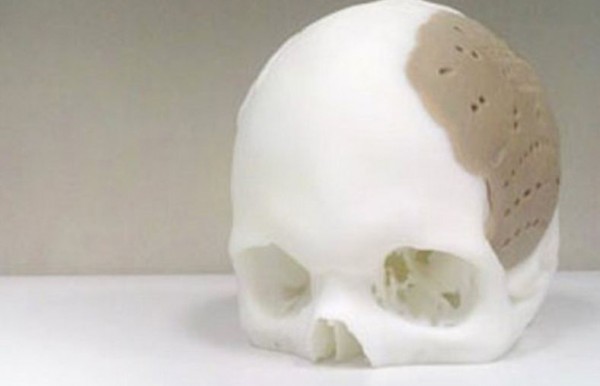Increasing Demand & Newer Processing Methods Could Make Titanium Less Expensive
| Eana Maniebo | | May 21, 2015 12:14 PM EDT |
(Photo : Oxford Performance Materials) Oxford 3D printed section of damaged skull
According to revered business journalist Tim Treadgold, advancements in the titanium processing technology can trim down the metal's exorbitant prices in the future.
Like Us on Facebook
He pinpointed the rise of metalysis, a newly developed titanium processing method that by-passes the chlorine-based stages involved in the traditional Kroll system. Kroll is a pyrometallurgical industrial process that utilises electrolysis to produce titanium.
The complexity of the process, which makes it time-consuming and expensive, has encouraged many research groups in the past to develop a faster, more efficient way of producing metallic titanium.
"If a new way of making titanium can bridge the gap between laboratory success and commercial production it will make a perfect fit with 3D printing technology which is starting to be used to make high-specification components such as jet-engine parts and medical appliances," Treadgold wrote.
Santiago, Chile-based White Mountain Titanium Corporation (OTCQB:WMTM) has also developed an effectual but cheaper technology for converting titanium concentrates into metal.
The Chinuka process is an electro-refining technology that produces high-grade titanium metal powder directly from rutile and ilmenite ore. The company also holds a sub-license to use Chinuka's patented electro-refining process-the "Chinuka Process"-to produce titanium metal directly from various types of titanium oxide concentrates.
White Mountain Titanium is also funding a titanium metal-focused research on the unexplored potential of the new process. The research is led by the University of Cambridge in England.
According to Industrial Research Reports, titanium dioxide nanomaterials have been at the center of research due to their low cost and simple production process since the advent of nanotechnology.
The increasing demand for titanium dioxide will help alleviate the increasing problems concerning the disparity in the supply and demand segment.
Titanium is among the most abundant minerals in the world. In the recent years, many titanium producers had troubles finding customers because of low demand.
The paints and coatings industry, as well as the automotive industry, experienced market slowdown in the past years especially after the global economic crisis. These two industries are the largest consumers of titanium in the world.
Surprisingly, the sudden popularity of cosmetic products with titanium dioxide nanoparticles enhanced the dwindling demand for the mineral. The increase in demand for nanomaterial-based products is one of the factors contributing to market growth.
According to a separate report conducted by Transparency Market Research, the increasing demand for lightweight vehicles will also stimulate the growth of the titanium market.
The rising demand could result to equilibrium in the segment, which is essential in trimming down titanium prices, making it a bit cheaper than it is now.
The global titanium dioxide market was estimated at $13.14 billion in 2013 and is expected to reach $17.12 billion by 2020. It is predicted to expand at a Compound Annual Growth Rate of 3.8 percent between 2014 and 2020.
Tags3D Printing, price of 3d printing, materials for 3d printing, lightweight market, supply and demand of titanium, companies that supply titanium dioxide, titanium dioxide, White Mountain Titanium, Chinuka Process
©2015 Chinatopix All rights reserved. Do not reproduce without permission
EDITOR'S PICKS
-

Did the Trump administration just announce plans for a trade war with ‘hostile’ China and Russia?
-

US Senate passes Taiwan travel bill slammed by China
-

As Yan Sihong’s family grieves, here are other Chinese students who went missing abroad. Some have never been found
-

Beijing blasts Western critics who ‘smear China’ with the term sharp power
-

China Envoy Seeks to Defuse Tensions With U.S. as a Trade War Brews
-

Singapore's Deputy PM Provides Bitcoin Vote of Confidence Amid China's Blanket Bans
-

China warns investors over risks in overseas virtual currency trading
-

Chinese government most trustworthy: survey
-

Kashima Antlers On Course For Back-To-Back Titles
MOST POPULAR
LATEST NEWS
Zhou Yongkang: China's Former Security Chief Sentenced to Life in Prison

China's former Chief of the Ministry of Public Security, Zhou Yongkang, has been given a life sentence after he was found guilty of abusing his office, bribery and deliberately ... Full Article
TRENDING STORY

China Pork Prices Expected to Stabilize As The Supplies Recover

Elephone P9000 Smartphone is now on Sale on Amazon India

There's a Big Chance Cliffhangers Won't Still Be Resolved When Grey's Anatomy Season 13 Returns

Supreme Court Ruled on Samsung vs Apple Dispute for Patent Infringement

Microsoft Surface Pro 5 Rumors and Release Date: What is the Latest?










